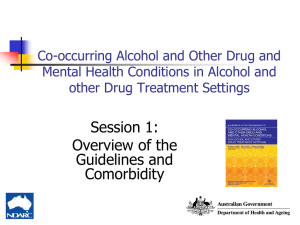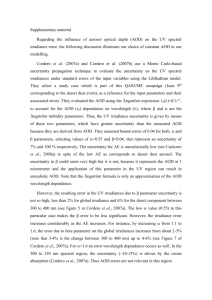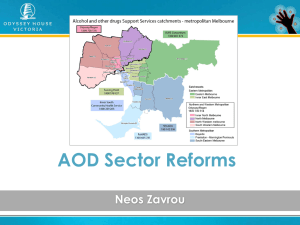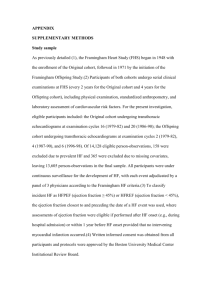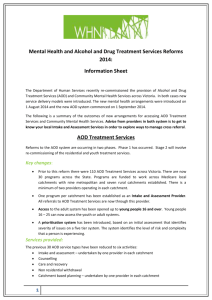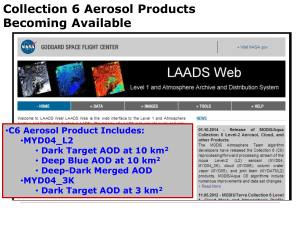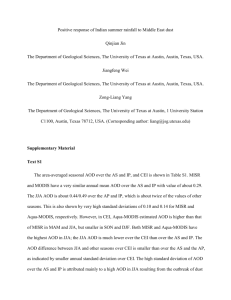Management and Treatment - National Drug and Alcohol
advertisement
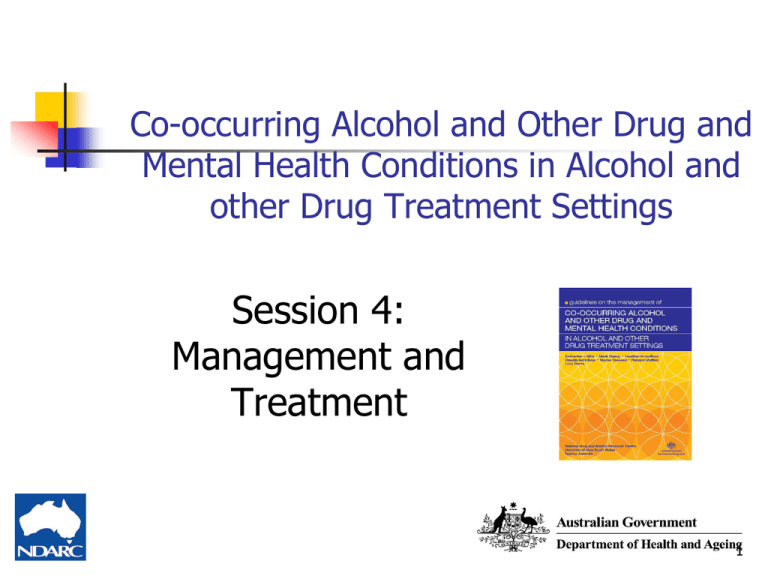
Co-occurring Alcohol and Other Drug and Mental Health Conditions in Alcohol and other Drug Treatment Settings Session 4: Management and Treatment 1 Comorbidity Guidelines Refer to: Chapters 7 and 8 Appendix C – Case Studies Appendices D, Q to Ee 2 Management vs Treatment Management of symptoms of mental illness to allow AOD treatment to continue with minimal disruption to retain clients in treatment Treatment refers to evidence-based practice for working with comorbidity Suggested treatments may be beyond scope of some AOD workers – awareness only 3 Managing Comorbidity Comorbid mental health symptoms can be managed and controlled whilst the client undergoes AOD treatment Consider whole person (from psychological, physical and socio-demographic perspectives) when managing symptoms of comorbid mental conditions 4 4 Managing Comorbidity Suicide risk should be monitored throughout treatment Motivational enhancement, simple CBT-based strategies, relaxation and grounding techniques can be useful in managing AOD use as well as mental health conditions 5 5 Managing Comorbidity Symptoms of trauma, grief, loss can be managed through anxiety management strategies and open discussion with client When dealing with more challenging clients ensure safe environment, set clear boundaries and place strong emphasis on engagement and rapport building 6 6 Managing Suicidality “Dos and Don’ts” 7 7 Managing Symptoms of Depression “Dos and Don’ts” 8 8 CBT and Symptoms of Depression Cognitive restructuring Pleasure and mastery events scheduling Goal setting Problem solving 9 9 Cognitive Restructuring A. Antecedent –Event that triggers automatic thoughts B. Beliefs about event – Automatic thoughts C. Consequences – feelings/behaviours that result from thoughts D. Disputing automatic thoughts – look for evidence to support/disprove these thoughts E. Alternative explanation – Rational alternatives to the automatic thought 10 Anxiety, Panic or Agitation “Dos and Don’ts” 11 11 Managing Symptoms of anxiety, panic or agitation Progressive muscle relaxation Controlled or abdominal breathing Calming response Visualisation and imagery Grounding 12 12 Managing Symptoms of Trauma “Dos and Don’ts” 13 13 Managing Grief and Loss “Dos and Don’ts” 14 14 Phases of Aggression (Source: NSW Department of Health 2007) 15 15 Managing Aggression Listen actively Acknowledge the problem/situation Separate from others Sit down Indicate possible options Encourage client to try these options 16 16 Managing Aggression “Dos and Don’ts” 17 17 Managing Symptoms of Psychosis “Dos and Don’ts” 18 18 Managing Personality Disorder Symptoms “Dos and Don’ts” 19 19 Managing Cognitive Impairment Techniques for problem-solving, planning, sequencing or decision-making difficulties Be clear and explicit in direction Encourage rehearsal of sequences Encourage routines Teach step-by-step decision-making and problemsolving Use timetables and other aids to help client plan 20 20 Managing Cognitive Impairment Techniques for slow information processing Summarise and repeat important points; have client relay these back to you Encourage questions Go slowly Techniques for poor attention/concentration Stress important points, repeat if necessary Minimise distractions 21 21 Managing Cognitive Impairment Techniques for poor memory Use memory aids, routines and written instructions Make sessions at routine times Limit amount of information covered, repeat key points, and go slowly Remind the client of appointments and key points 22 22 Treatment of Comorbidity Good treatment requires a good therapeutic alliance which includes client choice (including not to be involved in treatment) Some interventions have been designed for treatment of specific comorbidities; however, interventions have not been well researched In absence of research on comorbid disorders, recommended to use most effective treatments for each disorder 23 23 Treatment of Comorbidity Both psychosocial and pharmacological interventions have been found to have some benefit in treatment of comorbidities When pharmacotherapy is used, this should be accompanied by supportive psychosocial interventions 24 24 Models of Care Sequential treatment Parallel treatment Integrated treatment Stepped care 25 25 Motivational Interviewing with Co-occurring Disorders Increasing research base for applying MI with clients with co-existing disorders “Spirit” of MI can be useful for engaging clients to address both MH and AOD concerns Principles and strategies for using MI detailed in Appendix D of Comorbidity Guidelines 26 26 Cognitive Behavioural Techniques Evidence-based treatment approach used in both AOD and MH settings Particularly useful for managing symptoms of anxiety and depression Underpinnings of Relapse Prevention in both AOD and MH contexts See Appendix Q of Comorbidity Guidelines for an overview of techniques for using 27 27 Other Treatment Approaches Psychosocial groups Self-help groups Mindfulness training Contingency management. 28 28 Medications Medications form part of evidence-based practice in treatment of mental health concerns. Stabilising on appropriate medications and continued use whilst in AOD treatment can be essential to successful outcome for both AOD and MH 29 29 Commonly Prescribed Medications Antidepressants Mood stabilising medications Anti-anxiety Medications Antipsychotic Medications 30 30 Medication Adherence Making regimes as simple as possible Giving clear instructions Associating medication with predictable daily events such as meal times Using pill dispensing containers with daily organisers Using alarms 31 31 Medication Adherence Acknowledge any reluctance to take medications and allow client to express these concerns Motivational interviewing, contingency management and CBT have been shown to be particularly useful in improving medication compliance Facilitate discussion with medication prescriber if necessary 32 32 In sum… Range of approaches for managing symptoms of mental illness within AOD treatment settings Treatment of co-existing disorders can occur within AOD settings Further training in specific treatment approaches is recommended Refer to Chapters 7 and 8 and Appendices in Guidelines for further information 33 33

